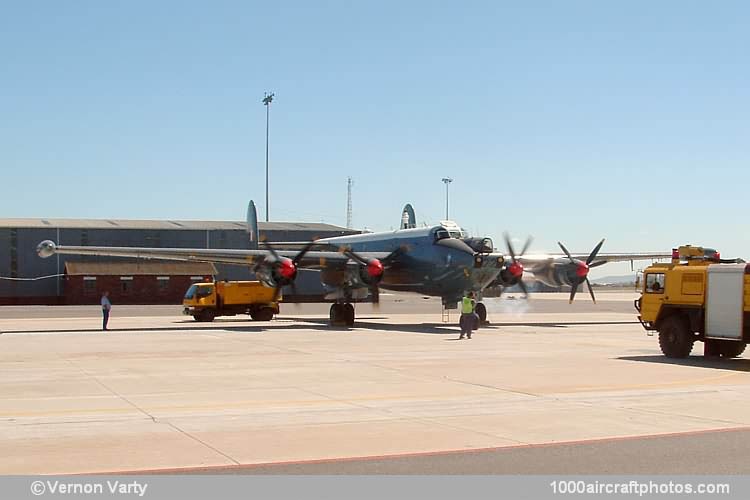Photographed at Ysterplaat AFB, Milnerton, Western Cape, South Africa, October 22, 2004, by Vernon Varty
10/31/2010. Remarks by
Vernon Varty, a retired member of the Friends of the South African Air Force Museum (SAAFM).
"This is one of eight Shackleton MR.Mk.3s ordered by the SAAF in 1954, and it was first flown February 7, 1958. Power was supplied by four 2455 hp Rolls-Royce Griffon 57A piston engines equipped with contra-rotating three-bladed propellers. The MR.Mk.3 was decommissioned by the SAAF in 1984. It had been used for maritime reconnaissance, anti submarine warfare and search and rescue missions along the southern African coast for a period of 26 years. Three of these magnificent aircraft where handed over to the SAAF Museum.
Throughout its service life, this Shackleton, s/n 1722, coded
"P" and affectionally nicknamed
"Pelican 22", was based at D.F. Malan Airport (now called Cape Town International), but sometime after formally retired on November 23, 1984, its ownership and location was transferred to the SAAFM, just 8 mls (13 km) north-west at Ysterplaat AFB. The Museum organized all subsequent flights,
including the one I enjoyed on November 22, 2004,
pilots for that flight were Brigadier-General Ben Kriegler (left) and Captain Peter Dagg.
The Shackleton wingspan is too great to allow the aircraft in to the hangar nose first. It gets hauled up so that the main wheels rest on two purpose-made
dollies, whose travel is at right-angles to the aircraft's longitudinal axis. The nose wheel is then turned also to 90° and the assembly is then towed wing tip first, in or out of the hangar.
Even with these measures, the hangar doors are still not wide enough (90 ft, 27.43 m), so the nose-armament, two 0.787 in (20 mm) Hispano cannons, has been
removed, reducing the length to 87 ft 4 in (26.92 m). This allows the aircraft to enter the hangar sideways, but with just 16 in (40 cm) clearance fore and aft. A major undertaking indeed, supervised and directed by the devoted ground engineer Henry James Potgieter.
Much has been written and said about Shackleton
WL790, a Mk.2 based in USA, it has often been proudly described as the last flying Shackleton in the world. And as far as Mks 1 and 2 are concerned this is certainly true. But 'Pelican 22' is the MR.Mk.3 version, the main differences being that the mark MR.Mk.3s are equipped with wing tip tanks, and use a tricycle landing gear configuration (whereas previous marks are tail-draggers).
WL790's well-documented final flight took place on December 16, 2007, from Texas to Arizona. It now rests at Prima Air & Space Museum, Tucson, Arizona. So the last flying Shackleton in the world was certainly 'Pelican 22', whose final flight happened on March 29, 2008. This was a typical flight which took it over the city of Cape Town, and then out over the Atlantic Ocean, then back over Robben Island to Ysterplaat AFB. This final flight was piloted by Captain Peter Dagg. The crew included flight engineer Bronkhorst and ground engineer Potgieter.
The final flight crew of P1722 included a number of the men who were part of the crew of another SAAF Shackleton, 'Pelican 16' which, en route to the UK in 1994, went down in the Western Sahara desert under the worst possible circumstances, pitch black night, not a light to be seen anywhere below, two engines failed within ten minutes of each other on the same wing, and none of the six huge propeller blades able to be feathered, and in a masterpiece of understatement co-pilot Peter Dagg said: "… that contributed to the aircraft's instability."
Pilot Eric Pienaar and Dagg struggled in pitch darkness and only two engines to achieve a trim state of lowest possible airspeed combined with lowest possible rate of descent, and had absolutely no idea of how many feet of air they had beneath them. The aircraft was pretty much destroyed on impact, but every member of the crew "disembarked" unaided, and as a former flyer myself I regard this as one of the most brilliant pieces of flying skill ever. These men are rightly regarded as heroes back here.
Everyone thought that the declining life of the main spar would be the cause of 'Pelican 22's retirement, but life is full of ironies. In actual fact, what finally stopped further flights was the flight crew, all well past retirement age, and the aircraft was finally grounded while still airworthy. It is lovingly wheeled out of its hangar for proud display when we have an Air Show, while another Shackleton, 'Pelican 20', s/n 1720, coded 'O', is plinthed as the gate guard at Ysterplaat."

